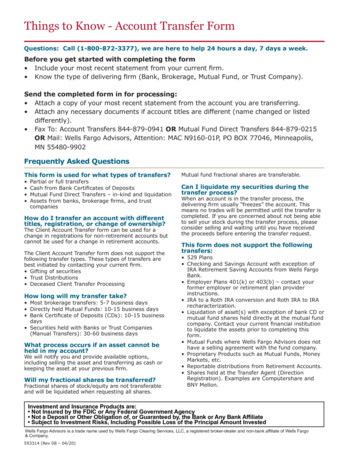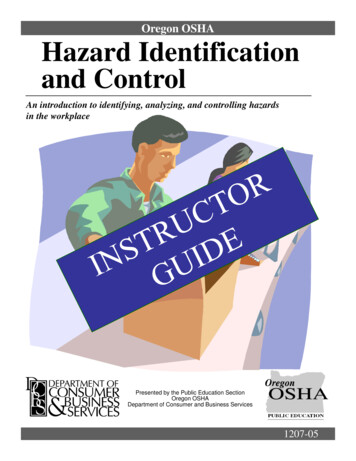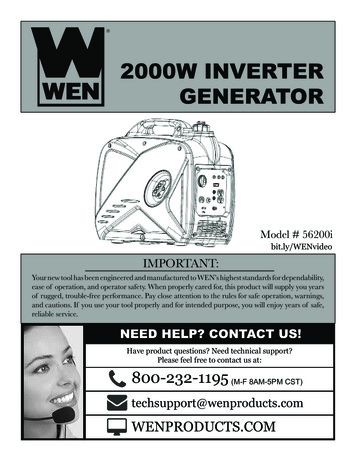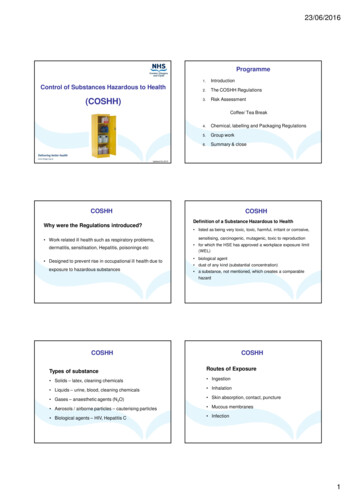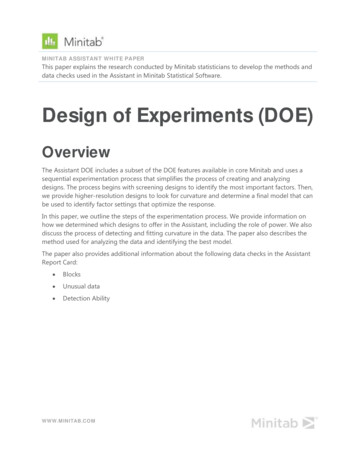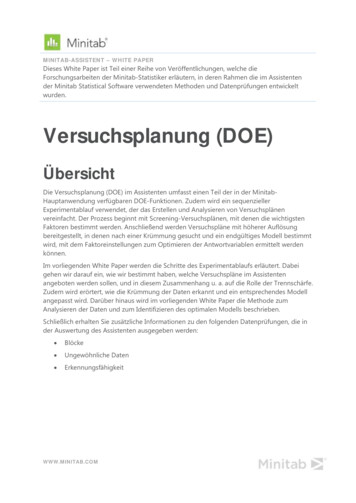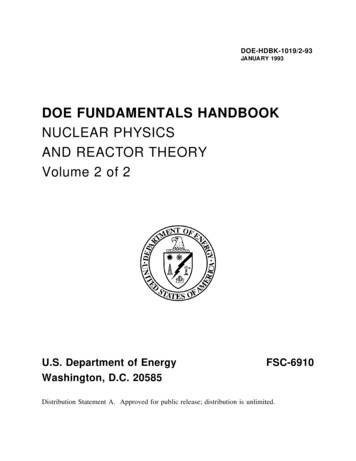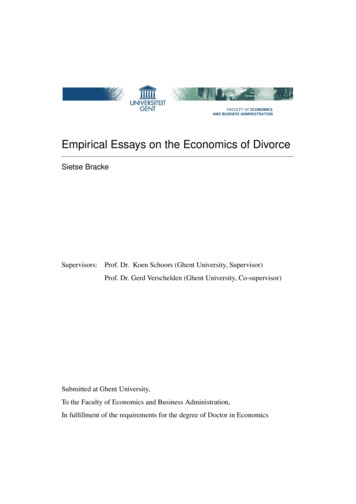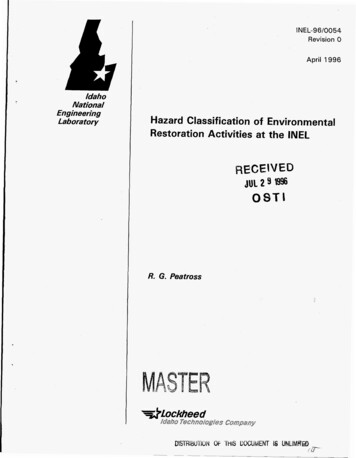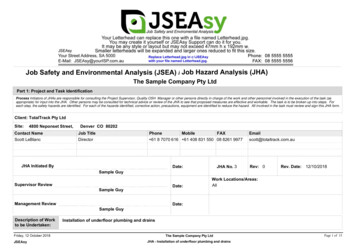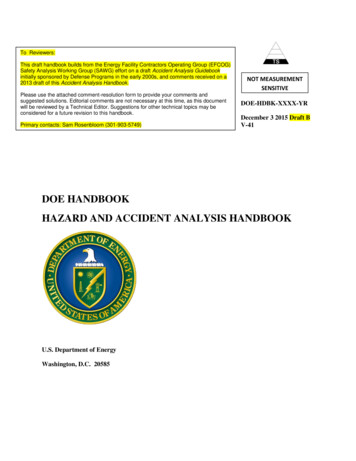
Transcription
To Reviewers:This draft handbook builds from the Energy Facility Contractors Operating Group (EFCOG)Safety Analysis Working Group (SAWG) effort on a draft Accident Analysis Guidebookinitially sponsored by Defense Programs in the early 2000s, and comments received on a2013 draft of this Accident Analysis Handbook.Please use the attached comment-resolution form to provide your comments andsuggested solutions. Editorial comments are not necessary at this time, as this documentwill be reviewed by a Technical Editor. Suggestions for other technical topics may beconsidered for a future revision to this handbook.Primary contacts: Sam Rosenbloom (301-903-5749)NOT MEASUREMENTSENSITIVEDOE-HDBK-XXXX-YRDecember 3 2015 Draft BV-41DOE HANDBOOKHAZARD AND ACCIDENT ANALYSIS HANDBOOKU.S. Department of EnergyWashington, D.C. 20585
DOE-HDBK-xxxx-20xxFOREWORDThis U.S. Department of Energy (DOE) Handbook is approved for use by all DOE elements and theircontractors.10 Code of Federal Regulations (CFR) 830, Nuclear Safety Management, Subpart B, Safety BasisRequirements, establishes safety basis requirements for Hazard Category (HC) 1, 2, and 3 DOE nuclearfacilities. This nuclear safety rule also identifies acceptable “safe harbor” methods for developing safetybasis documents, such as DOE-STD-3009-94 Chg. Notice 1, Preparation Guide for U.S. Department ofEnergy Nonreactor Nuclear Facility Documented Safety Analysis, or its successor document, DOE-STD3009-2014, Preparation of Nonreactor Nuclear Facility Documented Safety Analysis. This Handbookprovides additional details and examples supporting hazard and accident analysis, including applicablescientific theories, analysis techniques, practical examples, and lessons learned from DOE applicationsand experience. This Handbook is intended to help DOE contractors and personnel in preparing andreviewing documented safety analyses (DSAs). This Handbook is expected to serve as a resource and tofacilitate more consistent safety analyses for DOE nuclear facilities, and cost-effective development ofrequired safety analyses.This Handbook addresses the following key topics: safety analysis process, analysis of major accidenttypes (including fires, explosions, loss of confinement, chemical reactions, and natural phenomenaevents), nuclear criticality, source term analysis, radiological dispersion and consequence analysis, andchemical dispersion and consequence analysis.DOE Order 252.1A, Technical Standards Program, dated 2-23-2011, states that DOE Handbooks provide“a compilation of good practices, lessons-learned, or reference information that serve as resources onspecific topics.” This Handbook does not contain requirements statements and cannot be mademandatory via DOE regulatory provisions or contracts. The application of the techniques described inthis Handbook is not mandatory, and the methods and techniques may be used at the discretion ofcontractor line management.DRAFTBeneficial comments (recommendations, additions, deletions) and any pertinent data that may be of use inimproving this document should be sent to:Sam RosenbloomOffice Of Facility Safety Basis and Design, AU-31GTNU.S. Department of EnergyWashington, D.C. 20585Phone (301) 903-5749ii
DOE-HDBK-xxxx-20xxCONTENTSACRONYMS . XII1INTRODUCTION AND OVERVIEW . 11.11.21.32BACKGROUND .1APPLICABILITY AND RELATIONSHIP TO SAFETY BASIS DIRECTIVES .1SCOPE AND OUTLINE .2HAZARD ANALYSIS (HA) PROCESS . 12.1OVERVIEW .12.2HAZARD IDENTIFICATION AND CHARACTERIZATION.12.2.1 Data Gathering .22.2.2 Checklists/Data Recording .32.2.3 Hazard Summary Table Development .72.2.4 Standard Industrial Hazard Screening .102.3HAZARD EVALUATION .102.4HAZARD EVALUATION METHODS .132.4.1 What If Methodology .142.4.2 Hazard and Operational Analysis (HAZOP) .162.4.3 Failure Modes and Effects Analysis .192.4.4 Event Trees and Fault Trees .202.4.5 Nuclear Criticality Hazard Evaluation .212.4.6 Chemical Hazard Evaluation .222.5QUALITATIVE RESULTS FROM THE HAZARD EVALUATION .222.5.1 Qualitative Consequence .232.5.2 Qualitative Likelihood .292.5.3 Qualitative Risk .302.6CONTROL IDENTIFICATION DURING THE HAZARD EVALUATION .312.7HAZARD EVALUATION PRESENTATION IN DSA .31DRAFT3ACCIDENT ANALYSIS OVERVIEW . 13.1ACCIDENT TYPE SELECTION .13.2ACCIDENT ANALYSIS PROCESS .143.3ANALYSIS INPUTS AND ASSUMPTIONS .153.4BEYOND DESIGN/EVALUATION BASIS ACCIDENTS .173.5SOFTWARE QUALITY ASSURANCE (SQA) .213.5.1 Verification and Validation .223.5.2 Sensitivities and Uncertainties .223.5.3 Minimum Requirements for Application .233.5.4 ANS, ASME, and IEEE Standard Guidance for Computer Models .244EVALUATION OF IMPACTS FROM MAJOR ACCIDENT TYPES . 14.1INTRODUCTION .14.1.1 Information from Accident Analysis to Include in the DSA.24.2FIRE SCENARIO ANALYSIS .34.2.1 FIRE EVENT TYPES AND SCENARIOS .3iii
DOE-HDBK-xxxx-20xx4.2.2 Fire Analysis .54.3EXPLOSION ANALYSIS .94.3.1 TYPES OF EXPLOSIONS AND SCENARIOS .114.3.1.14.3.1.24.3.2Effects of Explosions 4.3.44.3.5TYPES OF EXPLOSIONS . 11Explosion Scenarios . 14Gas Generation and Flammable Gas Explosions . 20Flame Height in Vapor Cloud Explosion . 20Overpressure (Blast Effect) . 20Thermal Radiation . 20Fragmentation . 20Calculation Methods . 21Consequences of Explosions (Impact on SSC) .21Impacts on Material at Risk (MAR) .21Source Term (ST) Calculation .224.3.5.14.3.5.24.3.5.34.3.5.4Source Term Calculation for a Vapor Cloud Explosion . 27Source Term Calculation for an Overpressure (Blast Effect) . 27Source Term Calculation for Thermal Radiation . 28Source Term Calculation for Fragmentation . 284.4SPILLS . 294.4.1 Types of Loss of Confinement/Spills and Scenarios .294.4.2 Analysis of Spills .304.4.2.1Glovebox Spills . 314.4.2.2Material Handling and Waste Container Accidents . 314.4.2.3Over-pressurizations . 324.4.2.3.1 Pressurized Powder Releases . 324.4.2.3.2 Pressurized Liquid Releases. 324.4.2.4Aerodynamic Entrainment . 33DRAFT4.5ANALYSIS OF CHEMICAL REACTIONS .334.5.1 Organic-based Ion Exchange Resin Reaction .344.5.2 “Red Oil” Reaction .354.5.3 Organic Reaction Event .354.5.4 Hydroxylamine Nitrate reaction.374.5.5 Additional Comments on Chemical Reactions Accident Analsysis in a DSA .384.6NATURAL PHENOMENA EVENTS .384.6.1 NPH Event Types .384.6.2 NPH Event Analysis Overview .394.6.2.1 Accident Analysis for New Nuclear Facility or Major Modification DSA . 394.6.2.2 Accident Analysis for Existing Nuclear Facility DSA . 404.6.2.3 General Methodology . 434.6.3 Seismic Events .444.6.4 Extreme Wind Events .454.6.5 Flood and Precipitation Events .464.6.6 Lightning Events .474.6.7 Volcanic Eruption Events .494.6.8 Wildland Fires .504.7EXTERNAL MAN MADE EVENTS .514.7.1 Aircraft Crashes.51iv
DOE-HDBK-xxxx-20xx4.7.1.14.7.1.24.7.2Screening Analysis . 51Aircraft Crash Damage Assessment . 53Vehicle Crashes .544.7.2.1Vehicle Crash into Facility . 544.7.2.1.1 External Vehicle Crash Event Description and Analysis . 544.7.2.1.2 External Vehicle Crash Damage Assessment . 544.7.2.2Onsite Transportation Accident . 544.7.2.2.1 Onsite Transportation Event Description and Analysis . 554.7.3STATION BLACKOUT .564.7.3.15Station Blackout Event Description . 56SOURCE TERM ANALYSIS . 15.1INTRODUCTION .15.2CALCULATING SOURCE TERMS .15.2.1 Material at Risk (MAR).35.2.1.15.2.1.25.2.2Overview of Requirements, Guidance, and Practices for Identifying MAR . 3Examples for Identifying MAR . 4Damage Ratio (DR) .85.2.2.1 Overview of Requirements, Guidance, and Practices for Determining DR . 85.2.2.2Examples for Determining DR . 95.2.3Airborne Release Fraction (ARF) and Respirable Fraction (RF) .145.2.3.15.2.3.25.2.45.2.5Overview of Requirements, Guidance, and Practices for Determining ARF/RF . 14Examples for Determining ARF/RF . 27Airborne Release Rate (ARR) .29Leakpath Factor (LPF) .29DRAFT5.2.5.15.2.5.2Filtration LPF . 30LPF Modeling. 315.3CHEMICAL RELEASE SOURCE TERMS .335.4APPROPRIATENESS OF SOURCE TERMS .345.4.1 Adequate Technical Basis to Depart from Default or Bounding Values .356ATMOSPHERIC DISPERSION AND RADIOLOGICAL CONSEQUENCE ANALYSIS . 16.1ATMOSPHERIC DISPERSION.36.1.1 Introduction to Atmospheric Dispersion .36.1.2 Key Receptors.56.1.3 Meteorological Parameters Affecting Atmospheric Dispersion .66.1.3.1Wind Speed, Wind Direction, and Wind Direction Standard Deviations. 66.1.3.1.1 Wind Speed . 66.1.3.1.2 Wind Direction . 76.1.3.1.3 Wind Direction Standard Deviations . 76.1.3.2Vertical Temperature Profiles . 76.1.3.3Precipitation . 86.1.4Characterization of Meteorological and Site Data e . 8Joint Frequency Distribution (JFD) . 8Full Data Set Sampling . 9Treatment of Calm and Variable Winds . 9Meteorological Data Adequacy for Safety Analysis .10Atmospheric Stability Classes.11v
initions of Stability Classes . 11Methods of Calculating Stability Classes . 12Gaussian Plume Widths and Depths .15Typical and Unfavorable Dispersion Conditions .15DOE Central Registry of Radiological Dispersion and Consequence Analysis Codes .166.1.9.16.1.9.26.1.9.3MACCS2 . 23GENII . 24HOTSPOT . 256.1.10DOE-STD-3009-2014 Atmospheric Dispersion Options .256.1.11Dispersion Modeling Protocol.266.2RADIOLOGICAL CONSEQUENCE ASSESSMENT .336.2.1 Radiological Dose Fundamentals .336.2.1.16.2.1.26.2.1.36.2.2Types of Radiation. 34Nuclear Fission . 35Radioactive Decay and Half-lives . 35Effects of Radiation on the Body .366.2.2.1Dose Evaluations . 376.2.2.2Types of Dose . 376.2.2.2.1 Inhalation (Plume) . 386.2.2.2.2 Cloudshine. 406.2.2.2.3 Groundshine . 416.2.2.2.4 Prompt (Direct) Dose . 416.2.2.3Plutonium Equivalent Curies . 437CHEMICAL DISPERSION AND CONSEQUENCE ANALYSIS. 1DRAFT7.1INTRODUCTION .17.2CHEMICAL CONSEQUENCE ASSESSMENT FUNDAMENTALS .27.3CHEMICAL SCREENING CRITERIA .37.4CHEMICAL HEALTH EFFECTS ON THE HUMAN BODY .57.4.1 Chemical Concentrations and Exposure Time .57.4.1.17.4.1.27.4.1.37.4.1.47.4.27.4.3Chemical Exposure Time . 5Concentration-Dependent vs. Dose-Dependent Chemicals . 7Protective Action Criteria (PAC) for Releases of a Single Chemical . 8Protective Action Criteria (PAC) for Releases of Multiple Chemicals . 8Modes of Exposure and Routes of Entry of Toxic Chemicals that Result in Health Effects .9Toxic Chemical Acute Exposure Limits .97.4.3.17.4.3.27.4.3.3EPA Acute Exposure Guideline Levels (AEGLs) . 10AIHA Emergency Response Planning Guidelines . 10DOE/NA-41 PAC/TEELs . 107.4.4 Chemical Mixture Methodology.117.4.5 Chronic Health Effects of Toxic Chemicals on the Human Body: Carcinogenicity, Mutagenicity, andTeratogenicity .137.5TOXIC CHEMICAL RELEASE PHENOMENOLOGY AND SUBSEQUENT ATMOSPHERIC TRANSPORT ANDDIFFUSION .
Mar 15, 2012 · provides additional details and examples supporting hazard and accident analysis, including applicable scientific theories, analysis techniques, practical examples, and lessons learned from DOE applications and experience. This Handbook is intended to help DOE contractors and personnel in p
